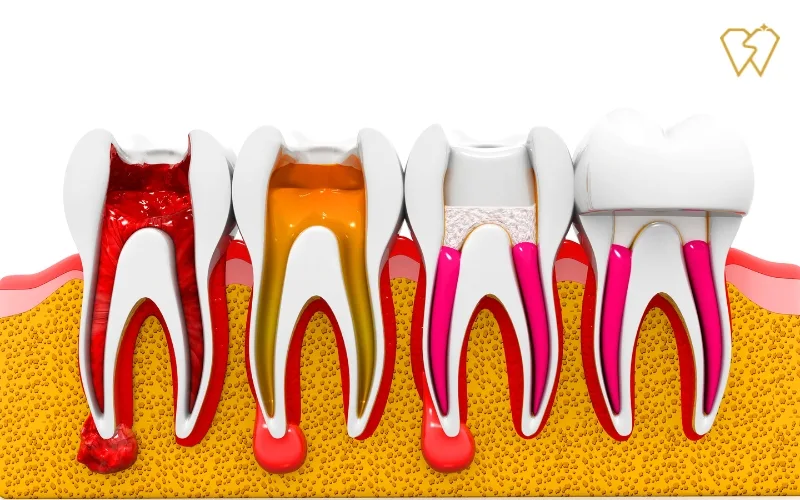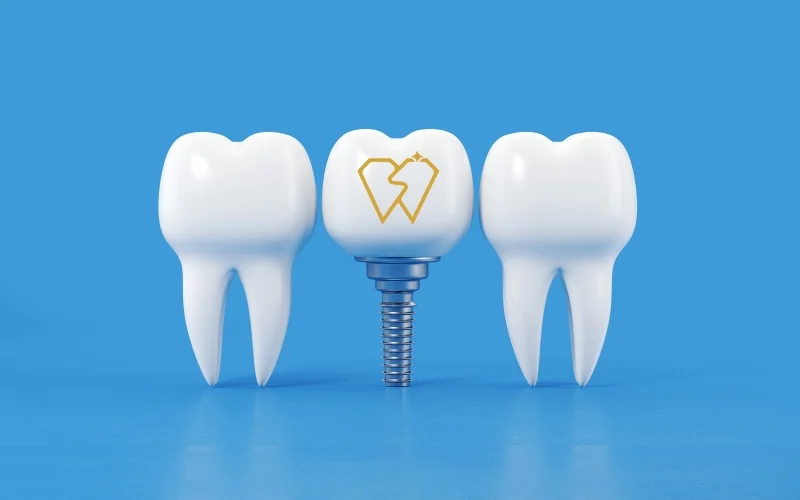A root canal procedure is a dental surgical treatment to relieve the pain caused by an infected tooth. During the treatment, the dentist removes the inflammatory pulp of the teeth. The dentist then cleans and disinfects the internal surface of the affected tooth and uses filling to seal the area.
When do you need a root canal?
A root canal procedure is needed when bacteria and other germs infiltrate the pulp inside your tooth. This commonly occurs when an infection of the tooth cavity is left untreated for an extended time. It might also happen if your tooth is fractured or damaged due to trauma.

A general dentist or an endodontist (root canal specialist) does these procedures. Because teeth towards the front of the mouth have fewer roots, general dentists can typically fix them. An endodontist handles the case if you need the treatment on a tooth with multiple roots or if your case is complicated.
Symptoms that you should be aware
In some circumstances, you may be unaware that you have an infected tooth. Many people, however, perceive specific root canal symptoms such as:
Persistent tooth pain: Tooth pain can arise from various dental issues. A root canal procedure can help if you are experiencing discomfort deep within your tooth. Your jaw, face, or other teeth may also be in pain.
Heat and cold sensitivity: If you feel discomfort in your teeth when you eat something hot or cold, a root canal procedure can be the solution.
Swollen gums: After tooth infection, pus can form in the surrounding area. This can result in puffy, inflamed, or painful gums.
Pimple or boil on the gums: You may get a pimple or boil on your gums. Pus may drain from the pimple, leaving a bad taste or odor.
Swollen jaw: Occasionally, pus does not drain from the spot. As a result, your jaw may swell visibly.
Tooth discoloration: Tooth discoloration occurs due to tooth pulp infection and a lack of blood supply to the tooth.
Pain on applying pressure: When you apply pressure to your tooth, you may experience discomfort. This could indicate that the nerves surrounding the pulp have been injured.
A chipped or cracked tooth: If you cracked a tooth in an accident, while playing sports, or biting down on something hard, bacteria might enter the tooth pulp.
Loose tooth: An infected tooth can affect the bone supporting it and may feel looser.
What is the prevalence of root canal treatment?
According to the American Association of Endodontists, about 41,000 procedures are performed daily in the United States. This equates to more than 15 million procedures each year.
How to prepare for the procedure?
Your healthcare professional can address any questions regarding the treatment before starting the procedure. You can prepare yourself by doing the following:
Take medications as directed: If an infection is present, your dentist may prescribe antibiotics or anti-inflammatory drugs.
Avoid smoking: Tobacco products interfere with your body’s natural ability to recover. Avoid smoking for several days before your appointment, and if possible, stop permanently.
Eat a healthy meal before your visit: Because the local anesthetic used during the procedure will numb your mouth for a few hours, eat something before your appointment.
How long does a root canal take?
Depending on the extent of the disease in your tooth, you may need one or two appointments. A root canal takes 45 to 60 minutes typically to perform. Treating a big tooth with many roots can take up more time.
Root canal procedure
Before starting the root canal procedure, your dentist will take dental X-rays of the affected tooth. This assists in determining the level of damage and ensuring that you get the best treatment choice. The following root canal treatment steps will be conducted during your procedure:
Anesthesia
The dentist administers a local anesthetic to numb the diseased tooth and surrounding tissues. Nitrous oxide, oral sedatives, and intravenous (IV) sedation are also used in dentistry to help you relax. Your doctor may recommend sedation if you have dental anxiety.
Dental dam application
Before beginning the procedure, your dentist places a tiny rubber dam over the area. This isolates the tooth and also keeps it dry during the procedure.
Access point
The pulp is then accessed through a small incision in the tooth’s crown.
Removal of the pulp
The contents of the root canal, including nerves, blood vessels, and soft tissues inside the tooth, are removed using tiny dental instruments.
Shaping canals
After removing the pulp, the dentist cleans, disinfects and shapes the pulp chamber and root canal.
Filling the canals
Next, the empty canals are filled with gutta-percha, a flexible, rubbery dental material.
Sealing the tooth
A temporary dental filling seals the tooth and prevents bacteria from re-entering.
The final restoration
A dental crown protects the repaired tooth and restores your bite. Crowns are manufactured to order and typically take two to three weeks to complete. When your crown is finished, the temporary filling is removed, and the permanent crown is installed. You may be able to acquire a crown during the same appointment in some cases.
Crowns are false teeth that are composed of porcelain or gold. The main advantage of crowns is their natural appearance. It may take multiple weeks to adjust to how your tooth feels after the surgery.
Does a root canal hurt?
Many people are concerned that root canal procedures would cause pain. However, because the source of the disease is removed during the process, most people get instant relief. Contact your dentist immediately if you have throbbing pain after your root canal treatment.
What should you expect after a root canal procedure?
While you should not have substantial pain after a root canal treatment, you may experience sensitivity for the first few days. These are typical symptoms that can be effectively treated with a prescription or over-the-counter pain medicines. Root canal recovery time usually takes one to two weeks for the root canal side effects to subside.
Benefits of a root canal procedure
There are various advantages to undergoing root canal treatment. This treatment can:
- Prevent the spread of disease to other teeth
- Relieve the symptoms of an infected tooth
- Reduce the possibility of jawbone injury
- Get rid of the need for teeth extractions
Root canal risks
Root canal procedures are thought to be both safe and effective. The technique has a high success rate of up to 98%. In some circumstances, certain problems may occur. This is especially true if your tooth has been broken beyond repair. Symptoms of a failed procedure include:
- Persistent pain
- Swollen gums
- Drainage or pus
Another possibility is that an abscess will form if some infected material persists or the antibiotics are ineffective.
If your procedure fails, your doctor will discuss your choices. Retreatment may be possible in some situations. Alternatively, it may be time to consider alternate procedures.
If you’re worried about having a root canal, talk to your dentist about having your tooth extracted instead. This usually involves using an implant or bridge to replace the broken tooth.
Root canal alternative treatment
Tooth extraction is the best alternative to root canal treatment. Even though it is preferable to save natural teeth wherever possible, extraction may be required to maintain dental health.
Other alternative procedures include pulp capping, pulpotomy, and extraction. Your dentist determines the appropriateness of these procedures. Call your dentist to learn more about alternative treatments.
Can you eat after the root canal treatment?
Yes. However, it is advisable to wait until the numbness is over. Anesthesia usually has a few hours of effect. Stick to soft foods like pasta, mashed potatoes, and yogurt for the first few days. You should also avoid biting or chewing on the treated tooth. Try chewing on the opposite side of your mouth until your final dental replacement is in place.
Root canal aftercare
- It is essential to keep the area clean after the procedure.
- To keep germs at bay, brush and floss normally and use an antimicrobial mouthwash.
- If you have a temporary filling, avoid chewing on the affected side until you get the crown.
How long do root canal treatments last?
Results are not guaranteed, as they are with other dental procedures. When the procedure is done correctly, the effects might endure a long time – potentially for the remainder of your life. You should have a follow-up appointment after your procedure.
Root canal cost
The root canal treatment cost is determined by various factors, including:
- The position of the tooth in your mouth
- Your location and the dentist
- Whether it’s a first procedure or retreatment
- Whether it is an emergency or a routine procedure
- What type of crown you choose
- Whether your insurance covers a portion or the entire treatment
Front teeth’ canals are less expensive as these teeth are easy to access for the dentist. Bicuspid teeth, also known as premolar teeth, are the teeth that come before your molars. As you may assume, they are more expensive than front teeth and less expensive than molars.
On average, a front tooth root canal cost in Malaysia is around RM700, and bicuspids cost roughly rm800-1000. These prices may be higher when done by a root canal specialist.
Molars towards the back are more difficult to reach and clean. Root canal treatment prices in those teeth are often the most expensive. Prices range from RM1200-1800. Re-treating a tooth is a complicated and time-consuming process and costs extra.
Conclusion
It is always preferable to save the natural tooth with a root canal rather than have it extracted. Do you need a root canal but are anxious to get it? Don’t worry, our dentists at Stellar Dental will walk you through every step.
Schedule your appointment now, and let us take care of your discomfort. Our dentist uses the latest dental technology to achieve the best results and maximum precision. Book an appointment today and say goodbye to your dental pain.









